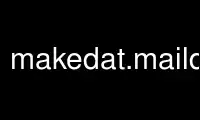
This is the command makedat.maildrop that can be run in the OnWorks free hosting provider using one of our multiple free online workstations such as Ubuntu Online, Fedora Online, Windows online emulator or MAC OS online emulator
PROGRAM:
NAME
makedat - create GDBM/DB files for maildrop
SYNOPSIS
makedat {-src=textfile} {-tmp=tmpfile} {-file=gdbmfile} [-cidr]
DESCRIPTION
The gdbm family of functions in maildrop provides access to GDBM/DB databases - simple
database files. The gdbm family of functions provide a way of quickly storing and looking
up key/data pairs.
You can use any program to create GDBM/DB database files. makedat is a quick utility to
create GDBM or DB files from plain text files.
The system administrator selects whether maildrop uses GDBM or DB database files and
whether makedat creates GDBM or DB database files as well.
The makedat command may not be available to you. GDBM/DB support in maildrop is optional,
and the system administrator may choose not to install GDBM/DB support and the makedat
command.
To see whether GDBM or DB support is being used, run the command "maildrop -v".
The textfile argument to makedat is a plain text file containing key/value pairs. Each
line in the text file contains a key value, followed by a tab and a data value. The data
value may be omitted, which defaults to "1". For example, the following three lines:
example.com
domain.com<tab>ok
foo.domain.com<tab>bad
Three key/value pairs are created: example.com, value "1"; domain.com, value "ok", and
"foo.domain.com", value "bad".
Empty lines in textfile, and lines starting with the # character, are ignored.
textfile can be "-", in which case standard input is used.
gdbmfile is the GDBM/DB file to create. If this file exists, its existing contents are
replaced.
tmpfile is a name of a temporary file in the same directory as gdbmfile. tmpfile is used
by makedat to create the GDBM file, then tmpfile is renamed to gdbmfile.
This approach foregoes any need for locking in order to be able to dynamically update
GDBM/DB files used by maildrop's gdbm functions. However, makedat does not use any locks
on tmpfile, so multiple instances of makedat using the same tmpfile are prohibited.
The -cidr flag specifies that the key is an IP netblock in CIDR notation. This flag
requires the Net::CIDR Perl module to be installed separately. Download Net::CIDR from
http://www.cpan.org.
Use makedat.maildrop online using onworks.net services
